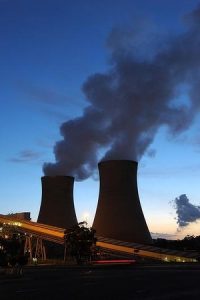Hazelwood coal mine is a major employer in Morwell, but also a source of pollution. Photo: Joe Armao
What is coal?
Formed from fossilised plant matter over millions of years, coal is combustible, carbon-rich rock found underground and widely used as a source of fuel. Most of the world’s energy needs are derived from the burning of fossil fuels such as coal, oil and natural gas. Australia is the world’s largest exporter of coal with more than half the quantity extracted sent overseas to countries like Japan, China, Korea and India. The resource is worth billions of dollars in income, jobs, tax and royalties, to the Australian economy.
In Australia, around 75 per cent of electricity is produced using coal: power stations burn the coal to heat water, creating the steam necessary to spin turbines and generate electricity. Both black and brown coal is mined here: black coal is of superior quality and used for overseas exports as well as generating power at home; whereas lower-grade brown coal, or “lignite”, is abundant in Victoria where it meets the state’s “base-load” power needs.
Steam billows from the cooling towers of the Loy Yang coal-fired power station in the Latrobe Valley. Photo: Carla Gottgens/Bloomberg
What issues are associated with the burning of coal?
The burning of coal produces carbon dioxide (CO2): a greenhouse gas considered to be a major contributor to global warming. Brown coal, which has a high moisture and low energy content, emits more CO2 than black. Given that Victoria’s lignite deposits have the capacity to supply electricity for more than500 years, efforts to lower emissions using new technologies are considered important. However, this dependence on coal for electricity generation makes Australia one of the highest “per capita” (per person) emitters of CO2 in the world.
Although the burning of fossil fuels still produces most of the world’s energy, a shift toward “renewable” sources such as wind and solar, is gaining momentum. This transition is mainly a response to the scientific consensus that human activity is driving the earth’s changing climate and that the burning of fossil fuels is largely responsible for a global rise in temperature. In the United States, for example, President Barack Obama has deviated from the vision of a coal-dominated future by acknowledging that “a low-carbon, clean energy economy can be an engine of growth” in coming decades. Data also indicates that China, currently the world’s largest greenhouse gas emitter, has begun to slow its coal usage.
What about Australia?
Despite a tentative global shift away from coal, Prime Minister Abbott says there would be “few things more damaging to our future” than leaving coal in the ground and insists that it will continue to “fuel human progress” as an “affordable energy source”. He says Australia should be an “energy superpower” and use “nature’s gifts” to supply the world’s energy. While agreeing that it is “prudent” to reduce carbon emissions where possible, Mr Abbott says that this should not be accomplished by “ostracising any particular fuel” or “harming economic growth”.
In providing the bulk of Australia’s electricity and billions of dollars to the economy through thriving exports, the fossil fuel industry continues to be supported by government policies with taxpayer funded subsidies, tax incentives and infrastructure approvals. However many argue that despite these benefits, there are public health and environmental issues that cannot be ignored. For example, the potential damage to the Great Barrier Reef as a result of the increased shipping of coal exports. Others say we can’t be “the world’s quarry” forever; suggesting that the nation’s future could be equally prosperous by further harnessing Australia’s other abundant “natural gifts” such as wind and sunshine and investing even more in clean energy.



